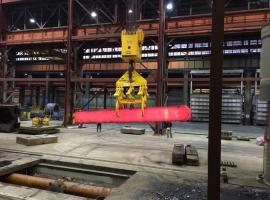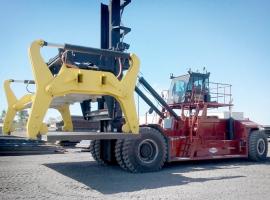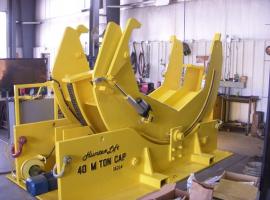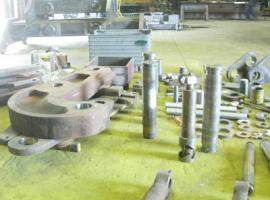Different Types of Below-the-Hook Lifting Devices
All below-the-hook lifting devices are constructed to standards set by the American Society of Mechanical Engineers (ASME). Some of the most common below-the-hook lifting devices include:
Sheet Lifter
A sheet lifter is a below-the-hook lifting device that can safely and efficiently lift large sheets of material, such as glass, metal, or wood. Sheet lifters typically have a vacuum attachment that allows them to grip the material securely while lifting it. This makes sheet lifters ideal for use in factories or warehouses where large sheets of material need to be moved regularly.
Structural and Mechanical Lifter
Mechanical lifters are categorized as load-supporting lifters used for heavy objects. It consists of a frame, a lifting platform, and a hydraulic system. The frame is typically made of steel or aluminum.
Structural lifters include the spreader beam, adjustable spreader bar, balanced pallet lifter, and balanced C lifter.
Mechanical lifters include a container lifter, drum-turning lifter, telescoping sheet lifter, telescoping coil grab, and power rotator.
Mechanical supporting lifters include a lifting beam (with hoisting ropes), a parallel coil grab, a simple sheet lifter, a lock bar sheet lifter, and a rack lifter.
Mechanical lifters are typically used in industrial applications where heavy objects must be lifted and moved at faster speeds and high cycle rates.
Vacuum Lifters
Vacuum lifters, also called gripping lifters, incorporate a pressure vacuum as part of the lifting mechanism, consisting of vacuum pads with suction cups on a below-the-hook frame. They use hydraulic, pneumatic, electrical, and mechanical power for lifting.
They can be heavy-duty, vertical-horizontal, coil, battery-powered, or mobile attachment vacuum lifters, allowing them a wide array of applications.
Different vacuum lifters include single pad, two-pad, multiped mechanical vacuum lifters, and four-pad powered vacuum lifters.
Close Proximity Operated Lifting Magnets
In this type of below-the-hook lifting device, a lifting magnet requires the operator to manually maneuver the lifting magnet on the load and guide it during the lift. Hence, the lifter is used in close vicinity of the operator.
Proximity-operated magnetic lifters include the proximity operated battery-powered, electrically powered, and manually controlled permanent magnet.
Remotely Operated Lifting Magnets
Another similar lifter to proximity-operated lifting magnets is the multi-magnet system which consists of individual lifting magnets suspended from a spreader beam.
It is described as a remotely operated lifting magnet that does not require the operator to be in close proximity to maneuver the lifter manually.
Remotely operated lifting magnets include remotely operated lifting electromagnet circular and the remotely operated lifting electromagnet rectangular.
Scrap and Material-Handling Grapples
Scrap and Material-handling grapplers are used to pick up large quantities of material sucha s scrap or debris and move them to material procession equipment.
Scrap and material-handling grapplers include a four-tine orange peel grapple, electrohydraulic grapple, three-in-one grapple, magnet grapple, and car body grapple.
Clamps
Clamp lifters come in various types, as certain clamps are unsuitable for specific tasks. Clamp lifters can be categorized into load-supporting clamps and friction-type pressure-gripping clamps.
Load supporting clamps include a web beam clamp and a horizontal clamp.
Friction-type pressure gripping clamps use friction to carry a load and include a screw clamp, drum of cylinder clamp, plate clamp, vertical axis coil clamp, coil positioner, ingot turner clamp, and a motor driver roll clamp.
Advantages of Below-the-hook lifting devices
• Safe and reliable load transport
• Save time and money
• Simple to use
• They can be used for difficult loads
• Can be customized
Bottom Line
No matter what type of below-the-hook lifting device you choose, select one rated for the specific load you'll be lifting. Now that you know more about the different below-the-hook lifting devices, it's time to start shopping around.
Search
categories
- Select...
- Safety (13)
- Lifting Equipment (12)
- Company (6)
- Materials (5)
- Education (4)
- Services (3)
- Industries (3)
- News (3)
- Cranes (2)
- History (1)
Recent Posts
Comprehensive Guide to Below the Hook Lifting Devices The 6 Advantages of Below The Hook Lifting Devices The Keys to Safety and Design Requirements of Below-the-Hook Lifting Devices Why Below the Hook Lifting Devices Are Essential to Lifting? Requirements for Below the Hook Lifting Devicesarchives
- April 2023 (1)
- January 2023 (1)
- October 2022 (1)
- September 2022 (1)
- August 2022 (3)
- July 2022 (3)
- July 2017 (1)
- June 2017 (1)
- May 2017 (1)
- April 2017 (1)
- January 2017 (1)
- December 2016 (1)





